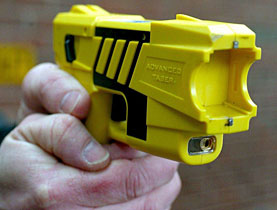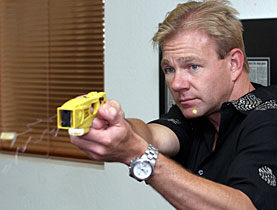Stun guns get go-ahead

The Swiss parliament has approved the use of stun guns as a means of restraint by the federal police as an alternative to regular weapons.
Both houses of parliament came out in favour of the Taser device on Tuesday, ending two years of inconclusive debate in the House of Representatives and the Senate.
Justice Minister Eveline Widmer-Schlumpf reassured opponents of the weapon that it would only be used in exceptional circumstances.
“Incapacitating devices are an alternative to firearms and can be used in particular against persons who have put themselves or other people at serious risk,” she told parliament.
“We attach a great deal of importance to the training of people who are allowed to use weapons,” she said.
Tasers deliver a high voltage electrical discharge which normally temporarily dazes the subject, who is likely to drop to the ground. They are said to cause intense pain, and have been described by a number of organisations, including the specialised United Nations committee, as a form of torture.
Tasers are also said to have led to a number of deaths in other countries. They are particularly dangerous to people with existing medical conditions, such as heart problems.
New law on restraint
The acceptance of Tasers by both houses of the Swiss parliament clears the last obstacle to elaborating a law to regulate the restraining measures available to the federal police services, in particular the federal security service, the federal criminal police and the frontier guards.
The law comes in response to at least two deaths that occurred in 1999 and 2001 when the police were restraining persons who were to be deported. It is supposed to ensure that such tragedies are avoided in future.
Fears that stun guns will be used during the deportation of foreigners have provoked concern among a number of human rights organisations. Widmer-Schlumpf categorically ruled out the use of Tasers when people were being deported by air.
She also promised that the government would clarify certain points when the law was drawn up, and stated that parliament would be asked to comment on the text.
Nevertheless, the human rights organisation, Amnesty International, expressed its continuing concern, while the Swiss Refugee Council said in a statement that the use of Tasers could in fact lead to more deaths.
The Swiss Medical Association is keen to stress that Tasers are weapons, and can be lethal in certain cases.
“As far as the deportation of foreigners is concerned, we think this method is somewhat disproportionate and other methods should be found, if possible,” René Raggenbass of the Association told swissinfo.
Use by police
Tasers are already authorised by several of Switzerland’s 26 cantons which have extensive autonomy for their police work.
One of these cantons is Bern, which has two devices it introduced only after a long evaluation phase.
“The devices are to be used only by the specially trained special intervention unit, which makes difficult or delicate arrests. For example, if there were a hostage-taking,” the force’s spokesman, Olivier Cochet, explained to swissinfo. They have to have authorisation from a senior officer before firing.
So far a Taser has only been used once, at the beginning of 2007, to subdue an armed man threatening to commit suicide whom the police feared might start firing into a crowded restaurant.
“It is something to be considered if a someone is putting other people in danger, but it wouldn’t necessarily be used each time,” Cochet said.
Reggenbass expressed confidence in the police and their ability to choose the appropriate way to deal with extreme situations.
“We just want to say that it is important not to trivialise the Taser. It is still a weapon and it can be lethal. That’s what you need to know, and you have to use it bearing that in mind,” he said.
swissinfo with agencies
The trademark Taser is an acronym for “Thomas A. Swift’s Electric Rifle”. Arizona inventor Jack Cover designed it in 1969 and named it after the science fiction teenage inventor and adventurer Tom Swift.
The Taser fires two barbed darts which embed themselves into the skin and deliver a series of around 50,000-volt electrical pulses for up to five seconds.
Experts say a shock lasting half a second will cause intense pain and muscle contractions. Two to three seconds will often cause the subject to become dazed and drop to the ground.
Although described by its supporters as non-lethal, in some circumstances people have died after being tased.
Taser International says the device is currently being used in 44 countries.
It is in common use in the US, but the introduction of Tasers into other countries, particularly in Europe, has been surrounded by controversy.
In most European countries possession of a Taser by private individuals is illegal.
A series of Taser-related deaths in Canada in 2007 received widespread publicity.
No deaths have been blamed on Tasers in Switzerland.

In compliance with the JTI standards
More: SWI swissinfo.ch certified by the Journalism Trust Initiative

You can find an overview of ongoing debates with our journalists here. Please join us!
If you want to start a conversation about a topic raised in this article or want to report factual errors, email us at english@swissinfo.ch.